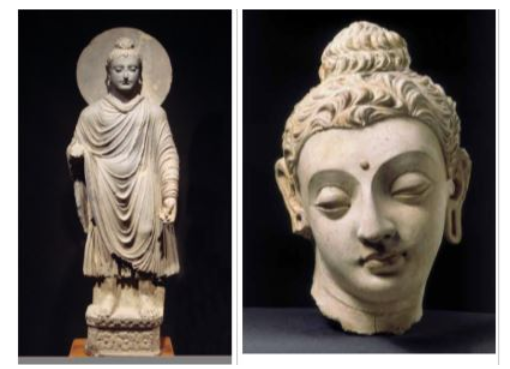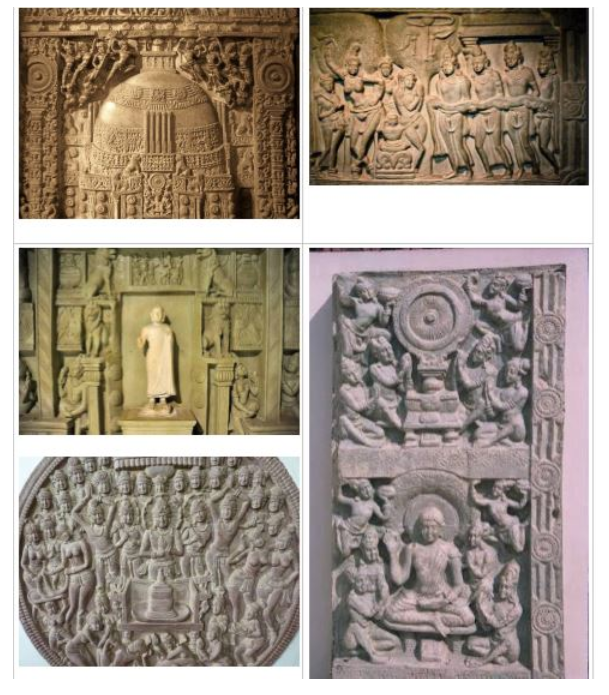During the post-Mauryan phase, the Shunga, Kushana, and Satavahana dynasties held sway, ushering in a transformative era in art and culture. This period laid the groundwork for the emergence of diverse schools of sculpture, such as the Mathura School of Art and the Gandhara School, which subsequently played a pivotal role in the evolution of temple architecture.
Several key factors contributed to the flourishing of art and culture during this phase:
- The geographical expanse of each kingdom influenced the artistic styles and regional variations.
- The availability of local materials influenced the choice of media for artistic expression.
- Local traditions of craftsmanship infused unique characteristics into the artworks.
- Political requirements and royal preferences played a crucial role in shaping the art produced. Notably, Satavahana queens made donations to Buddhist monks in the Western Ghats region, resulting in the construction of caves such as Karle and Kanheri.
- While these dynasties predominantly patronized Brahmanism, they continued to support Buddhism and Jainism, albeit on a smaller scale compared to Ashoka's time.
- During this phase, state patronage persisted, albeit to a lesser degree, as local entities like guilds and common citizens began to assume more significant roles in the development of art and sculpture.
- Various motifs, particularly those featuring yakshas and yakshis, gained widespread popularity. The "Shilabhanjika" motif, depicting a female figure gracefully grasping a tree, was particularly prominent during this period.
Kushana Period
The era of Kushana rule witnessed a remarkable acceleration in the development of art and sculpture, marking the inception of a Golden Age in Indian art.
The Kushana dynasty played a pivotal role in fostering vibrant cultural exchanges between India and Central and Eastern Asia, thereby facilitating the interchange of ideas with advanced traditions from the ancient world, including Graeco-Roman traditions.
- During this period, the foundation for various schools of art was laid, and excellence flourished in multiple domains, encompassing religion, philosophy, and literature.
- A significant milestone in the evolution of Buddhism occurred during the Kushana rule, as it experienced its first major schism, resulting in the division of Buddhism into Hinayana and Mahayana branches.
- Mahayana Buddhism, in particular, exerted a profound influence on the development of sculpture, as it allowed for the portrayal of the Buddha in human form.
Mathura and Gandhara Schools of Art
- Both the Mathura and Gandhara Schools of Art were situated within the domain of the Kushana rule.
- The Mathura School of Art holds the distinction of being the place where the first representation of the Buddha emerged, later influencing other regions, including Gandhara.
- These artistic traditions flourished under the political patronage of the Kushana dynasty.
- Over time, these two schools of art eventually converged and amalgamated their influences and styles.
Mathura School of Art
Origin:
- Located in the heartland of India.
- Initially had minimal foreign influence.
- Later, influenced by the Gandhara School of Art.
Material:
- Primarily used spotted red sandstone from Sikri mines.
Key Features:
- Early Mathura sculptures did not aim for anatomically accurate depictions of Buddha, resulting in somewhat disproportionate images.
- These images were characterized by the composition of 32 major and 80 minor Laksana (attributes).
- Expressions were often lacking, with Buddha typically shown sitting cross-legged.
- Emphasized boldness in expression, conveying power more than compassion.
- Hair was typically undressed.
- Drapery and clothing were portrayed in a simple manner.
- Most images featured the Abhaya Mudra (gesture of fearlessness).
Centers:
Prominent centers of the Mathura School of Art included Mathura itself, Sarnath, and Kosambi.
Types of Images:
- The Mathura School of Art produced a variety of sculptures, including representations of Buddha, Jain Tirthankaras, Hindu gods and goddesses like Vishnu, Shiva, Parvati, Kuber, and images of emperors, with Kanishka being one of the most significant.
Patrons:
- This school of art developed under the patronage of the Kushana dynasty and reached its zenith during the Gupta period (325-600 AD).
Gandhara School of Art
Origin:
- Located in the Gandhara region in the northwestern part of the Indian subcontinent, intersected by the Silk Road, and situated on the border of the subcontinent.
- Exposed to ideas from various regions such as China, Greece, Rome, and Persia due to its strategic location.
- Resulted in the fusion of Indian ideas with those from other cultures, giving rise to a distinct art school.
- Strong influence from Greco-Roman norms, earning it the moniker "Greco-Buddhist School of Art."
Material:
- Primarily employed black stone and stucco.
Key Features:
- Closely associated with Mahayana Buddhism.
- Exhibited a significant influence from the old Greek School of Art, incorporating Indian themes while using Greco-Roman materials and ideas.
- Primary theme centered on representations of Buddha and Bodhisattvas.
Image Features:
- Characterized by finer details and realistic representations.
- Depictions of Buddha in various mudras (hand gestures).
- Sculptures featured curly or wavy hair, anatomical accuracy, and a sense of spatial depth.
- Notable for the portrayal of wrinkles on the skin, expressions of compassion, and a muscular body frame.
- Transparent garments with natural-looking folds and flowing drapery.
- Images were highly expressive, emphasizing muscularity, drawing parallels with the depiction of Greek gods, notably resembling the Greek god Apollo.
Centers:
- Prominent centers of the Gandhara School of Art included Taxila, Begram, Bamiyan, and Peshawar, spanning across Afghanistan and northwestern India.
Patrons:
- Supported by the Shakas and Kushanas.

Greek, Roman, and Indian Influence
Greek:
- The Gandhara sculpture's portrayal of Buddha as a 'man-god' drew inspiration from Greek mythology.
- Greek sculpture favored mythological and idealized statues, while Roman sculpture leaned toward realism. (Greek Sculptures = represent gods | Roman Sculptures are mainly used for depictions of Kings and Generals)
- The extensive use of stucco plaster in Gandharan artwork found its roots in Greek art.
- The inclusion of wavy hair in sculptures, a feature adopted by Romans, can also be traced back to Greek influence.
- The depiction of masculinity in Gandharan sculptures was influenced by the muscular representation of Greek gods.
Roman:
- Roman sculpture evolved from Greek sculpture, resulting in notable similarities between the two. Nevertheless, discernible differences did exist.
Drapery:
- The drapery of the robes adorning Buddha in Gandhara sculpture bore a striking resemblance to the drapery seen in Roman imperial statues.
Indian:
- Indian influence was evident in the jewelry featured in these sculptures.
- The core concept of Buddhism, as depicted in these artworks, was inherently Indian in origin.
Mathura vs. Gandhara School of Art
This type of comparison is often essential for state-level PCS examinations.
Mathura School
- Origin: Indigenous development with minimal foreign influence. Later influenced by the Gandhara School.
- Material Used: Spotted red sandstone.
- Religions: Buddhism, Jainism, and Hinduism all represented.
- Image Features: Minimal attention to detailed sculpting, Buddha is portrayed as stout.
- Area: Prominent centers in Mathura and Kosambi.
- Patronage: Supported by the Kushana dynasty and later the Guptas.
Gandhara School
- Origin: Strong Greek-Roman influence, known as the Greco-Buddhist School of Art. Initially inspired by Hellenistic features.
- Material Used: Stucco.
- Religions: Mainly focused on Buddhism.
- Image Features: Finer details, realistic representations, and Buddha depicted in various mudras (hand gestures).
- Area: Prominent centers in Taxila, Bagram, and Bamiyan, among others.
- Patronage: Supported by the Kushana dynasty and the Shakas.
Amravati School of Art
- Location: Situated in the Guntur district of Andhra Pradesh, India. Also referred to as the Vengi School of Art, it developed in the lower valleys of the Krishna-Godavari region.
- Patrons: Flourished during the time of the Satavahanas and Ikshvakus.
- Material: Primarily employed white marble.
- Place: Predominantly found in Andhra Pradesh, particularly in the Krishna-Godavari Valley.
- Theme:
- Focused on depicting the life of Buddha and Jataka stories.
- Embraced both Mahayana and Hinayana Buddhism.
- Narratives from the life of Buddha and Bodhisattva, such as events related to his birth, miracles, and enlightenment, took center stage.
- Features:
- Sculptures featured Buddha with curly hair, influenced by Greek artistic elements.
- Emphasized the portrayal of kings, princes, and palaces.
- Gateways adorned with images of lions.
- Amaravati sculptures were characterized by lean, beautiful, curvy, and mobile figures, akin to the style found in the Gandhara School of Art.
- Frequently incorporated floral and lotus motifs.
- Depicted various postures that conveyed the activities of each individual, often exuding joyfulness.
- Female figurines were represented in various postures, showcasing a better depiction of feminine beauty compared to the Mathura School of Art.
- The influence of the Amaravati School of Art extended to later period sculpture in South India, Sri Lanka, and Southeast Asia.

Sarnath School
- Location: Sarnath is a place near Varanasi and is famous because it's where Buddha gave his first sermon.
- Development: The Sarnath School of Art came into being much later than the Gandhara and Mathura Schools. Some scholars believe that it was closely linked to the Gupta Period.
- Themes: This school mainly focused on Buddha and also included depictions of Bodhisattvas.
- Distinctive Features:
- Halos around the figures were well-developed.
- The hair of the sculptures was more detailed than in Mathura but not as intricate as in Gandhara. It had small, dot-like structures.
- The drapery was simple and lacked the natural cloth appearance seen in Gandhara. It was almost transparent.
- The art was primarily made using red sandstone.
- The sculptures conveyed a sense of calm and inner tranquility.
- The most common depiction in this school was Buddha preaching, often with the Dharmachakra Mudra.
- Stupa Architecture: In Sarnath, the architecture of stupas was notably different from other places, like Sanchi. For instance, the Dhamekh Stupa and Chaukhandi Stupa, both belonging to this school, showcased unique designs.


